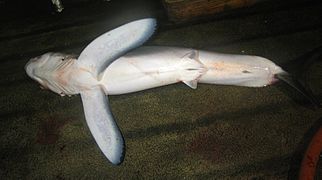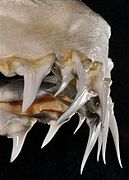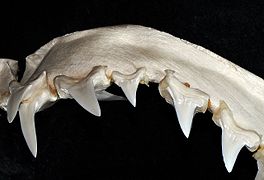Langfin mako shairk
| Langfin mako shairk | |
|---|---|

| |

| |
| Scientific classification | |
| Kinrick: | Animalia |
| Phylum: | Chordata |
| Cless: | Chondrichthyes |
| Subcless: | Elasmobranchii |
| Superorder: | Selachimorpha |
| Order: | Lamniformes |
| Faimily: | Lamnidae |
| Genus: | Isurus |
| Species: | I. paucus |
| Binomial name | |
| Isurus paucus Guitart-Manday, 1966
| |

| |
| Range o the langfin mako shairk | |
| Synonyms | |
|
Isurus alatus Garrick, 1967 Lamiostoma belyaevi Glückman, 1964 Isurus oxyrinchus (non Rafinesque, 1810) misapplied | |
The langfin mako shairk (Isurus paucus) is a species o mackerel shairk in the faimily Lamnidae, wi a probable warldwide distribution in temperate an tropical watters. An uncommon species, it is teepically lumpit thegither unner the name "mako" wi its better-kent relative, the shortfin mako shark (I. oxyrinchus). The langfin mako is a pelagic species foond in moderately deep watter, haein been reportit tae a deth o 220 m (720 ft). Growin tae a maximum lenth o 4.3 m (14 ft), the slimmer big an lang, broad pectoral fins o this shairk suggest that it is a slawer an less active soummer than the shortfin mako.
Langfin mako shairks are predators that feed on smaw schuilin bony fishes an cephalopods. Whether this shairk is capable o elevatin its bouk temperatur abuin that o the surroondin watter lik the ither members o its faimily is uncertain, tho it possesses the requisite physiological adaptations. Reproduction in this species is aplacental viviparous, meanin the embryos hatch frae eggs inside the uterus. In the later stages o development, the unborn young are fed nanviable eggs bi the mither (oophagie). The litter size is teepically twa, but mey be as mony as aicht. The langfin mako is o limitit commercial value, as its meat an fins are o lawer quality than those o ither pelagic shairks; it is caucht unintentionally in law nummers athort its range. The Internaitional Union for Conservation of Nature haes assessed this species as vulnerable due tae its rarity, law reproductive rate, an continuin bycatch mortality.
Taxonomy an phylogeny
[eedit | eedit soorce]The oreeginal description o the longfin mako wis published in 1966 bi Cuban marine scientist Darío Guitart-Manday, in the scienteefic jurnal Poeyana, based on three adult specimens frae the Caribbean Sea. A earlier synonym o this species mey be Lamiostoma belyaevi, describit bi Glückman in 1964. Housomeivver, the teep specimen designatit bi Glückman consists o a set o fossil teeth that coud no be confirmit as belangin tae the langfin mako, sicweys the name paucus teuk precedence ower belyaevi despite bein published later.[2] The specific epithet paucus is Laitin for "few", referrin tae the rarity o this species relative tae the shortfin mako.[3]
The sister species relationship atween the langfin an shortfin makos haes been confirmit bi several phylogenetic studies based on mitochondrial DNA. In turn, the closest relative o the twa mako shairks is the great white shairk (Carcharodon carcharias).[4] Fossil teeth belangin tae the langfin mako hae been recovered frae the Muddy Creek marl o the Grange Burn fuirmation, sooth o Hamilton, Australie, an frae Mizumani Group in Gifu Prefectur, Japan. Baith deposits date tae the Middle Miocene epoch (15–11 million years ago (Mya).[5][6]
Distribution an habitat
[eedit | eedit soorce]Widely scattered records suggest that the longfin mako shark haes a warldwide distribution in tropical an wairm-temperate oceans; the extent of its range is difficult tae determine due tae ramfeesion wi the shortfin mako. In the Atlantic Ocean, it is kent frae the Gulf Stream aff the east coast o the Unitit States, Cuba, an soothren Brazil in the wast, an frae the Iberie Peninsula tae Ghana in the east, possibly includin the Mediterranean Sea an Cape Verde. In the Indie Ocean, it haes been reportit frae the Mozambique Channel. In the Paceefic Ocean, it occurs aff Japan an Taiwan, northeastren Australie, a nummer o islands in the Central Pacific northeast o Micronesie, an soothren Californie.[2]
A inhabitant o the open ocean, the longfin mako generally remains in the upper mesopelagic zone durin the day an ascends intae the epipelagic zone at nicht. Aff Cuba, it is maist frequently caucht at a deth o 110–220 m (360–720 ft) an is rare at deths abuin 90 m (300 ft). Aff New Sooth Wales, maist catches occur at a deth o 50–190 m (160–620 ft), in auries wi a surface temperatur aroond 20–24 °C (68–75 °F).[7]
Description
[eedit | eedit soorce]The langfin mako is the lairger o the twa makos an the seicont-lairgest species in its faimily (efter the great white), reachin upwairds o 2.5 m (8.2 ft) in lenth an wichin ower 70 kg (150 lb); females graw lairger than males.[8] The lairgest reportit langfin mako wis a 4.3-m-lang female caucht aff Pompano Beach, Florida, in Februar 1984.[7] This species haes a slim, fusiform shape wi a lang, pointit snoot an lairge een that lack nictatin membranes (protective third eelids). Twal tae 13 tuith rows occur on aither side o the upper jaw an 11–13 tuith rows are on aither side o the lawer jaw. The teeth are lairge an knife-shapit, athoot serrations or seicontar cusps; the ootermaist teeth in the lawer jaw protrude prominently frae the mooth. The gill slits are lang an extend ontae the tap o heid.[2][8]
The pectoral fins are as lang or langer than the heid, wi a nearly straicht front margin an broad tips. The first dorsal fin is lairge wi a roondit apex, an is placed ahint the pectoral fins. The seicont dorsal an anal fins are tiny. The caudal peduncle is expandit laterally intae strang keels. The caudal fin is crescent-shapit, wi a smaw notch near the tip o the upper lobe. The dermal denticles are elliptical, langer than wide, wi three tae seiven horizontal ridges leadin tae a toothed posterior margin. The coloration is daurk blue tae grayish black abuin an white belaw. The unpaired fins are daurk except for a white rear margin on the anal fin; the pectoral an pelvic fins are dark abuin an white belaw wi shairp gray posterior margins. In adults an lairge juveniles, the aurie beneath the snoot, aroond the jaw, an the oreegin o the pectoral fins hae dusky mottlin.[2][8]
-
The maist distinctive featurs o the langfin mako shairk are its lairge pectoral fins
-
Jaws
-
Lawer teeth
-
Upper central teeth
-
Upper teeth
Biologie an ecologie
[eedit | eedit soorce]The biology o the langfin mako is little-kent; it is somewha common in the wastren Atlantic an possibly the central Paceefic, whilk in the eastren Atlantic, it is rare an ootnummert ower 1000-faud bi the shortfin mako in fishery landins.[1][2] The langfin mako's slender bouk an lang, broad pectoral fins evoke the oceanic whitetip shairk (Carcharhinus longimanus) an the blue shairk (Prionace glauca), baith slaw-cruisin shairks o upper oceanic watters. This morphological similarity suggests that the langfin mako is less active than the shortfin mako, ane o the fastest an maist energetic shairks.[2] Lik the ither members o its faimily, this species possesses blood vessel coontercurrent exchynge seestems cried the rete mirabilia (Laitin for "wonderful net", singular rete mirabile) in its trunk musculatur an aroond its een an brain. This seestem enables ither mackerel shairks tae conserve metabolic heat an mainteen a heicher bouk temperatur than thair environs, tho whether the langfin mako is capable o the same is uncertain.[2]
The langfin mako haes lairge een an is attractit tae cyalume sticks (chemical lichts), impleein that it is a visual hunter. Its diet consists mainly o smaw, schuilin bony fishes an squids. In October 1972, a 3.4-m-lang female wi the breuken bill frae a swuirdfish (Xiphius gladias) lodgit in her abdomen wis caucht in the northeastren Indie Ocean; whether the shairk wis preyin on swuirdfish as the shortfin mako daes, or encoonterit the swuirdfish in some ither aggressive context is no kent.[2][7] Adult langfin makos likely hae nae naitural predators, whilk young indwallers mey faw prey tae lairger shairks.[8]
As in ither mackerel shairks, the langfin mako is aplacental viviparous an teepically gies birth tae twa pups at a time (ane inside each uterus), tho a 3.3-m-lang female pregnant wi aicht well-developed embryos wis caucht in the Mona Passage near Puerto Rico in Januar 1983.[7] The developin embryos are oophagous; ance thay deplete thair supply o yolk, thay sustain thairsels bi consumin lairge quantities o nanviable eggs ovulatit bi thair mither. Nae evidence o siblin cannibalism is seen as in the saund teeger shairk (Carcharias taurus). The pups measur 97–120 cm (3.18–3.94 ft) lang at birth, relatively lairger than the young o the shortfin mako, an hae proportionally langer heids an pectoral fins than the adults.[8][9] Captur records aff Florida suggest that durin the winter, females soum intae shallaw coastal watters tae gie birth.[10] Male an female shairks reach sexual maturity at lenths aroond 2 m (6.6 ft) an 2.5 m (8.2 ft), respectively.[7]
Human interactions
[eedit | eedit soorce]
Nae attacks on humans hae been attributit tae the langfin mako shairk.[2] Nivertheless, its lairge size an teeth mak it potentially dangerous.[3] This shairk is caucht, generally in law nummers, as bycatch on langlines intendit for tuna, swuirdfish, an ither pelagic shairks, as well as in anchort gillnets an on heuk-an-line. The meat is marketed fresh, frozen, or dreed an saltit, tho it is considert tae be o poor quality due tae its mushy textur. The fins are considered tae be o lawer quality for uise in shairk fin soup an aw, tho are valuable enough that capturt shairks are aften finned at sea.[1] The carcasses mey be processed intae ainimal feed an fishmeal, whilk the skin, cartilage, an jaws are o value an aw.[8][10]
The maist significant longfin mako catches are bi Japanese tropical langline fisheries, an those shairks occasionally enter Tokyo mercats. Frae 1987 tae 1994, Unitit States fisheries reportit catches (discardit, as this species is wirthless on the North American mercat) o 2–12 tons per year.[1] Syne 1999, retention o this species haes been prohibitit bi the U.S. National Marine Fisheries Service Fishery Management Plan for Atlantic shairks.[11] Langfin makos wur ance significant in the Cuban lagline fishery, comprisin a saxt o the shairk landins frae 1971 tae 1972; mair recent data frae this fishery are no available. The IUCN haes assessed this species as vulnerable due tae its uncommonness, law reproductive rate, an susceptibility tae shairk fishin gear. It haes been leetit unner Annex I o the Convention on Migratory Species Migratory Shark Memorandum of Understanding.[12] In the North Atlantic, stocks o the shortfin mako hae declined 40% or mair syne the late 1980s, an concerns exist that populations o the langfin mako are follaein the same trend.[1]
See an aw
[eedit | eedit soorce]References
[eedit | eedit soorce]- ↑ a b c d e Reardon, M.B.; Gerber, L. & Cavanagh, R.D. (2006). "Isurus paucus". IUCN Reid Leet o Threatened Species. Version 2008. Internaitional Union for Conservation o Naitur. Retrieved 25 December 2008. Cite uses deprecated parameter
|last-author-amp=(help)CS1 maint: ref=harv (link) - ↑ a b c d e f g h i Compagno, L.J.V. (2002). Sharks of the World: An Annotated and Illustrated Catalogue of Shark Species Known to Date (Volume 2). Rome: Food and Agriculture Organization. pp. 115–117. ISBN 92-5-104543-7.
- ↑ a b Ebert, D.A. (2003). Sharks, Rays, and Chimaeras of California. London: University of California Press. pp. 120–121. ISBN 0-520-23484-7.
- ↑ Dosay-Abkulut, M. (2007). "What is the Relationship within the Family Lamnidae?" (PDF). Turkish Journal of Biology. 31: 109–113. Archived frae the original (PDF) on 20 Apryle 2016. Retrieved 19 December 2016.
- ↑ Fitzgerald, E. (2004). "A review of the Tertiary fossil Cetacea (Mammalia) localities in Australia" (PDF). Memoirs of Museum Victoria. 61 (2): 183–208. Archived frae the original (PDF) on 23 August 2008. Retrieved 19 December 2016.
- ↑ Yabumoto, Y. & Uyeno, T. (1994). "Late Mesozoic and Cenozoic fish faunas of Japan". The Island Arc. 3: 255–269. doi:10.1111/j.1440-1738.1994.tb00115.x. Cite uses deprecated parameter
|lastauthoramp=(help) - ↑ a b c d e Martin, R.A. Biology of the Longfin Mako (Isurus paucus). ReefQuest Centre for Shark Research. Retrieved on December 25, 2008.
- ↑ a b c d e f Wilson, T. and Ford, T. Biological Profiles: Longfin Mako Archived 2019-04-17 at the Wayback Machine. Florida Museum of Natural History Ichthyology Department. Retrieved on December 25, 2008.
- ↑ Gilmore, R.G. (6 Mey 1983). "Observations on the Embryos of the Longfin Mako, Isurus paucus, and the Bigeye Thresher, Alopias superciliosus". Copeia. American Society of Ichthyologists and Herpetologists. 1983 (2): 375–382. doi:10.2307/1444380. JSTOR 1444380.
- ↑ a b Froese, Rainer and Pauly, Daniel, eds. (2008). "Isurus paucus" in FishBase. December 2008 version.
- ↑ Fowler, S.L.; Cavanagh, R.D.; Camhi, M.; Burgess, G.H.; Cailliet, G.M.; Fordham, S.V.; Simpfendorfer, C.A. & Musick, J.A. (2005). Sharks, Rays and Chimaeras: The Status of the Chondrichthyan Fishes. International Union for Conservation of Nature and Natural Resources. pp. 106–109. ISBN 2-8317-0700-5. Cite uses deprecated parameter
|last-author-amp=(help) - ↑ Memorandum of Understanding – Migratory Sharks. Convention on Migratory Species. Downloaded on February 14, 2012.
Freemit airtins
[eedit | eedit soorce]| Wikimedia Commons haes media relatit tae Longfin mako shark. |






